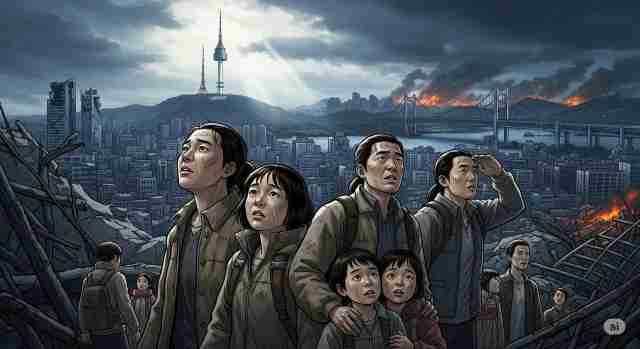Korean Disaster Film Recommendations: Why “Concrete Utopia” Is the Must-Watch of the Genre
Exploring the Rise of Korean Disaster Cinema and Why “Concrete Utopia” Stands Out
Korean disaster films have captured the imagination of global audiences, blending large-scale spectacle with deeply human stories. In recent months, the genre has seen a powerful resurgence, propelled by new streaming releases, festival buzz, and a surge in online recommendations. Among the standout titles, “Concrete Utopia” has emerged as the most recommended Korean disaster film for international viewers, offering not just thrills but a moving exploration of survival and morality.
Key Takeaways
- Korean disaster films are known for their ability to evoke empathy, drawing viewers into the lives of ordinary people faced with extraordinary circumstances.
- “Concrete Utopia” has become the centerpiece of current English-language discussions about Korean disaster films, offering a gripping narrative and intense performances.
- The genre has seen a surge in global recognition, with titles like “Train to Busan” and “Ashfall” gaining international acclaim.
Table of Contents
- The Rise of Korean Disaster Cinema
- Why “Concrete Utopia” Stands Out
- The Power of Empathy in Disaster Storytelling
- Streaming Success and Global Buzz
- The Broader Landscape: Other Notable Korean Disaster Films
- Actionable Strategies for New Viewers
- Why These Films Matter
- Final Thoughts
The Rise of Korean Disaster Cinema
Korean disaster films are more than just visual spectacles. They are known for their ability to evoke empathy, drawing viewers into the lives of ordinary people faced with extraordinary circumstances. This unique approach has set Korean films apart from typical Hollywood disaster fare, focusing as much on character and society as on the catastrophe itself.
The genre’s global recognition soared after the release of Train to Busan in 2016, a film that combined heart-stopping action with emotional depth. Its success opened the floodgates for international audiences seeking more Korean disaster narratives, leading to a wave of streaming acquisitions and festival acclaim for new releases.
Why “Concrete Utopia” Stands Out
Concrete Utopia has become the centerpiece of current English-language discussions about Korean disaster films. Set in a post-earthquake Seoul, the film follows a group of survivors who band together in a single apartment complex, navigating not just the physical dangers of a shattered city but also the psychological and moral dilemmas that arise when society’s rules break down.
What sets “Concrete Utopia” apart is its focus on the human condition under pressure. The story delves into the shifting dynamics among the survivors, exploring themes of community, trust, and the lengths people will go to protect their loved ones. The performances are intense and nuanced, drawing viewers into the emotional heart of the disaster.
The Power of Empathy in Disaster Storytelling
Korean disaster films resonate because they mirror real-world anxieties and hopes. The characters are relatable, their struggles universal. In “Concrete Utopia,” the audience is invited to imagine themselves in the survivors’ shoes, grappling with impossible choices and the weight of responsibility.
This emotional grounding is a hallmark of the genre. Titles like Tunnel, Pandora, and Ashfall also center on ordinary people thrust into chaos, emphasizing resilience, sacrifice, and the search for meaning amid destruction. These stories remind us that even in the darkest times, humanity’s capacity for empathy and solidarity endures.
Streaming Success and Global Buzz
The renewed interest in Korean disaster films is reflected in recent streaming data and online engagement. Following its release, Concrete Utopia broke into Netflix’s global Top10 Non-English Films, holding the top Asian film spot for several weeks. This visibility has driven a surge in recommendations and discussions across platforms like Reddit, X (Twitter), and K-entertainment blogs.
Industry analytics show that search volumes for “Korean disaster movies recommended” have more than doubled in the past six months, with related hashtags trending regularly. Fans debate the merits of different titles, often highlighting the unique blend of spectacle and emotional depth that defines Korean disaster cinema.
The Broader Landscape: Other Notable Korean Disaster Films
While “Concrete Utopia” is currently the most recommended, the genre offers a rich selection of films, each with its own take on catastrophe and survival:
- Train to Busan: A runaway hit that set the standard for emotional zombie thrillers.
- Ashfall: Focuses on a volcanic eruption and the desperate efforts to prevent further disaster.
- Pandora: Explores the fallout from a nuclear power plant accident, with a strong emphasis on personal sacrifice.
- Tunnel: Centers on a man trapped in a collapsed tunnel, highlighting the psychological toll of isolation.
- The Tower: A harrowing tale of survival in a burning skyscraper.
- Exit: Balances humor and suspense as characters escape a city engulfed in toxic gas.
- The Great Flood: An upcoming Netflix release promising a fresh take on disaster survival in a flooded Seoul.
- Good News: Another highly anticipated film, inspired by a real-life hijacking, set to premiere at the Toronto International Film Festival.
Actionable Strategies for New Viewers
For those new to Korean disaster films, starting with “Concrete Utopia” is highly recommended. Its accessible story, powerful performances, and timely themes make it an ideal introduction to the genre. Afterward, exploring other titles like “Train to Busan,” “Tunnel,” or “Ashfall” can deepen your appreciation for the range and depth of Korean disaster storytelling.
Engage with online communities on Reddit or X (Twitter) to discover fan-curated lists and recommendations. Streaming platforms like Netflix regularly update their catalogs with both classic and new Korean disaster films, making it easy to stay current with the latest releases and trends.
Why These Films Matter
At their core, Korean disaster movies are about more than surviving catastrophe. They ask difficult questions about morality, community, and what it means to be human in the face of overwhelming odds. By blending spectacle with substance, these films offer not just entertainment but a mirror to our own fears and hopes.
The current wave of international interest speaks to the universal power of these stories. Whether you’re a longtime fan or a newcomer, Korean disaster films invite you to witness not just the end of the world, but the beginning of something profoundly human.
Trending Korean Disaster Films: At a Glance
| Title | Core Theme | Why It Resonates |
|---|---|---|
| Concrete Utopia | Post-earthquake survival, morality | Psychological depth, gripping social dynamics |
| Train to Busan | Zombie outbreak on a train | Emotional stakes, family bonds |
| Ashfall | Volcanic eruption, national crisis | High-stakes action, teamwork |
| Pandora | Nuclear disaster, sacrifice | Social critique, personal heroism |
| Tunnel | Collapse, isolation | Psychological suspense, hope |
| The Tower | Fire in skyscraper | Spectacle, human courage |
| Exit | Toxic gas, urban escape | Humor, resourcefulness |
| The Great Flood | Flooded city, AI and survival | Futuristic themes, new Netflix release |
| Good News | Hijacking, rescue mission | Real-life inspiration, international intrigue |
Final Thoughts
The surge in global interest for Korean disaster films is more than a passing trend. It reflects a growing appreciation for stories that combine heart-stopping action with genuine emotional resonance. “Concrete Utopia” stands at the forefront, but the entire genre offers a wealth of experiences for viewers seeking both thrills and empathy.
By engaging with these films, international audiences are not only entertained—they are invited to reflect on the resilience and compassion that define us all.


